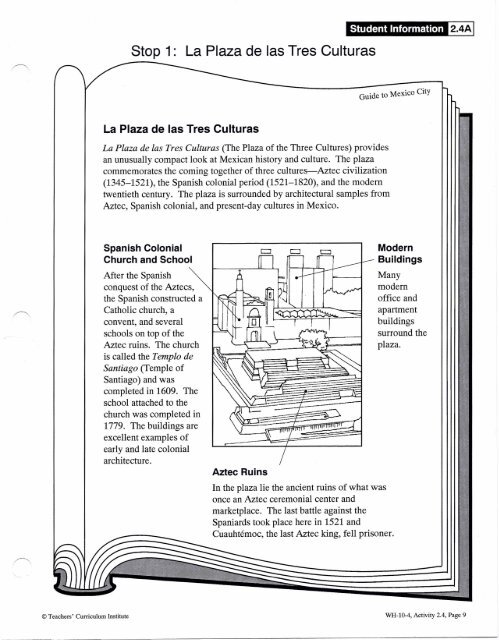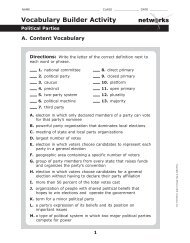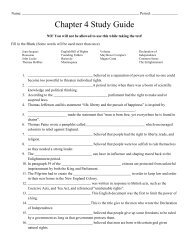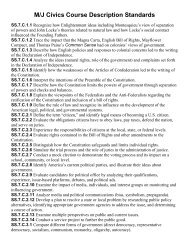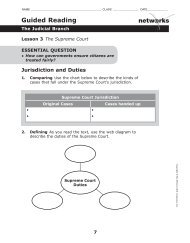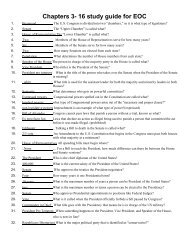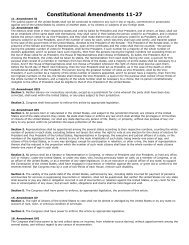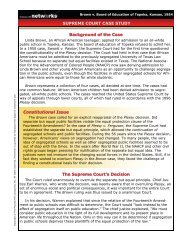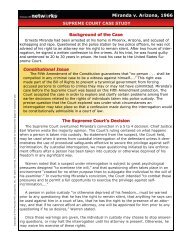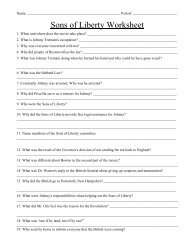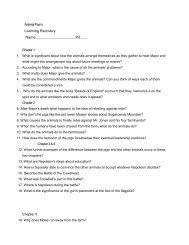You also want an ePaper? Increase the reach of your titles
YUMPU automatically turns print PDFs into web optimized ePapers that Google loves.
© Teachers' Curriculum Institute<br />
<strong>Stop</strong> 1: <strong>La</strong> <strong>Plaza</strong> <strong>de</strong> <strong>las</strong> <strong>Tres</strong> <strong>Culturas</strong><br />
<strong>La</strong> <strong>Plaza</strong> <strong>de</strong> <strong>las</strong> <strong>Tres</strong> <strong>Culturas</strong><br />
<strong>La</strong> <strong>Plaza</strong> <strong>de</strong> <strong>las</strong> <strong>Tres</strong> <strong>Culturas</strong> (The <strong>Plaza</strong> of the Three Cultures) provi<strong>de</strong>s<br />
an unusually compact look at Mexican history and culture. The plaza<br />
commemorates the coming together of three cultures-Aztec civilization<br />
(1345-1521), the Spanish colonial period (1521-1820), and the mo<strong>de</strong>rn<br />
twentieth century. The plaza is surroun<strong>de</strong>d by architectural samples from<br />
Aztec, Spanish colonial, and present-day cultures in Mexico.<br />
Spanish Colonial<br />
Church and School<br />
After the Spanish<br />
conquest of the Aztecs,<br />
the Spanish constructed a<br />
Catholic church, a<br />
convent, and several<br />
schools on top of the<br />
Aztec ruins. The church<br />
is called the Templo <strong>de</strong><br />
Santiago (Temple of<br />
Santiago) and was<br />
completed in 1609. The<br />
school attached to the<br />
church was completed in<br />
1779. The buildings are<br />
excellent examples of<br />
early and late colonial<br />
architecture.<br />
Aztec Ruins<br />
In the plaza lie the ancient ruins of what was<br />
once an Aztec ceremonial center and<br />
marketplace. The <strong>las</strong>t battle against the<br />
Spaniards took place here in 1521 and<br />
Cuauhtemoc, the <strong>las</strong>t Aztec king, fell prisoner.<br />
Stu<strong>de</strong>nt Information<br />
Gui<strong>de</strong> to Mexico City<br />
Mo<strong>de</strong>rn<br />
Buildings<br />
Many<br />
mo<strong>de</strong>rn<br />
office and<br />
apartment<br />
buildings<br />
surround the<br />
plaza.<br />
2.4A<br />
WH-1O-4, Activity 2.4, Page 9
e<br />
>-l<br />
(1)<br />
.,<br />
o<br />
e-<br />
~~<br />
o<br />
c<br />
3,<br />
~<br />
8<br />
S<br />
~<br />
g'<br />
r;<br />
~•.....<br />
o<br />
.~<br />
~
@<br />
;;l .,<br />
g<br />
Ul<br />
Q<br />
3.<br />
Sc<br />
B<br />
rr<br />
~.<br />
<br />
~•....<br />
o<br />
J..<br />
~<br />
~.<br />
~.<br />
tv<br />
-~<br />
~<br />
~ •....<br />
•....<br />
) ) )<br />
Resi<strong>de</strong>ntial Areas<br />
~ Upper C<strong>las</strong>s<br />
m3 Middle C<strong>las</strong>s<br />
•• LowIncome<br />
m'<br />
~ •<br />
~ Industrial Areas<br />
~ Commercial Areas<br />
--- Principal Road<br />
Map of the Neighborhoods of Mexico City<br />
by Economic C<strong>las</strong>s<br />
<strong>Stop</strong> 3: High-Income Neighborhood<br />
Hola (hello). My name is Jose<br />
Fernan<strong>de</strong>z, and I'm a professor of urban<br />
studies. I study the challenges facing cities,<br />
such as Mexico City. As you may have noticed,<br />
housing in Mexico City reflects the wi<strong>de</strong> economic<br />
gap between the rich and poor.<br />
As the map to the left shows, low-income Mexicans tend to<br />
live in the east and north. Many poor people began coming to<br />
Mexico City in the 1960s to claim land on the outskirts of the<br />
city. They became known as "squatters" because they built<br />
shelter from discar<strong>de</strong>d wood or cardboard on any land that was not<br />
being used by its owner. Squatter settlements often lack common<br />
services, such as safe drinking water and health-care facilities.<br />
Middle-c<strong>las</strong>s housing settlements are scattered throughout Mexico<br />
City. Middle-income Mexicans have access to basic government<br />
services, such as water, electricity, sewage, and public<br />
transportation.<br />
The rich live in extreme luxury in high-income neighborhoods<br />
in the west and south. They have easy access to Mexico<br />
City's best hospitals, schools, and shopping areas.<br />
Now we are trying to <strong>de</strong>crease the rapid growth of<br />
Mexico City so that the government can<br />
provi<strong>de</strong> housing and services for all<br />
citizens, rich and poor.<br />
!'l<br />
01::00<br />
»
e...,<br />
"., 0<br />
:r<br />
"til.<br />
o c:<br />
3.<br />
0<br />
E.<br />
c:<br />
a.....<br />
::><br />
'" :0'.<br />
<br />
)<br />
Oland<br />
[Jwater<br />
<strong>La</strong>ke<br />
Tenochtitlan and Surrounding<br />
Areas in 1521<br />
<strong>Stop</strong> 4: Environmental Studies Station<br />
Water Air<br />
Neighborhood of<br />
Xochimilco<br />
Mexico City in 1995<br />
Since Aztec times, the lakes in the Valley of Mexico have<br />
been drained, leaving little water in the mo<strong>de</strong>rn-day city.<br />
Oland<br />
o water<br />
• Fresh water-for drinking and farming-has always been<br />
scarce in the Valley of Mexico because many of the lakes are<br />
salty. The Aztecs, Spanish, and mo<strong>de</strong>rn Mexicans have all had<br />
to import fresh water.<br />
• From 1973 to 1993 Mexico City's population swelled from<br />
10 million to over 20 million. The city consumes approximately<br />
16,000 gallons of water per second.<br />
• Mexico City relies on water brought in at great expense from<br />
far away.<br />
• 8 million Mexicans living in Mexico City lack running water.<br />
)<br />
• The air of Mexico City is extremely polluted.<br />
• 45 percent of all cars in Mexico are in the Mexico City.<br />
Some scholars estimate that as much as 85 percent of<br />
pollution in Mexico City comes from cars.<br />
• Each day over three million vehicles and 35,000 factories in<br />
the Valley of Mexico emit about 13,000 tons of pollutants into<br />
the air.<br />
• Every year vehicles and factories produce 51,000 tons<br />
of sulfur dioxi<strong>de</strong>, a <strong>de</strong>structive air pollutant. Other air<br />
pollutants, including carbon monoxi<strong>de</strong> and lead,<br />
create headaches, eye and skin irritations, and<br />
breathing problems.<br />
Feet Above<br />
Sea Level<br />
13,000<br />
11,500<br />
10,000<br />
8,500<br />
Volcan Tlaloc<br />
Mexico City<br />
Pico <strong>Tres</strong> Padres<br />
7,000 ...1....------- --1<br />
In this topographical profile of the Valley of Mexico we can see why air<br />
pollution is easily trapped in the valley.<br />
)


